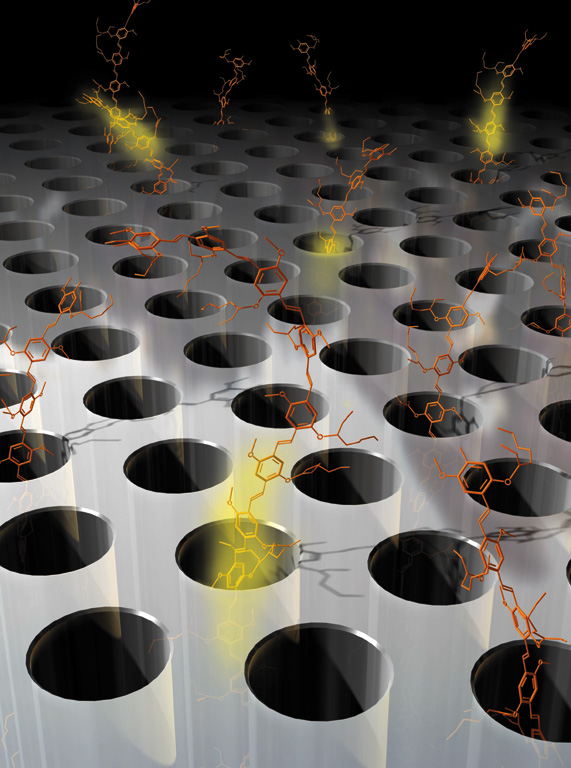Because conjugated polymer chains tend to twist and bend, they have segments with different conjugation lengths. Energy tends to flow from the shorter conjugation length segments to the longer conjugation length segments (just like a particle in a
 1-D box, the shorter segments have a larger energy gap). The
question is, does this energy flow more easily between polymer chains (via
Förster transfer) or can it move more quickly along the backbone of
a single chain? By stuyding conjugated polymers embedded in the channels
of mesoporous silica (see Artist's conception at left) in collaboration with
the Tolbert
group, we have been able to determine that energy (excitons) flow much more
quickly between chains of conjugated polymers than along the backbone of
a single chain. The idea is that there are 2 different types of polymer
chains in the silica/polymer composite material: aligned chains in
the interior of the pores (which are also isolated because there is only
physical room for one polymer chain per pore) and randomly-oriented chains
that can be in contact with each other on the exterior of the pores.
The randomly-oriented segments on the outside tend to have shorter conjugation
lengths than the straight polymer segments held inside the channels.
When the sample is excited, energy (represented by yellow glows in the Figure)
spontaneously flows from the short segments on the outside of the pores to
the long sements inside the pores by moving along the backbone of the chain:
we can monitor this process by watching the polarization of the fluorescence
from the polymer increase with time. What we find is that energy takes
several hundred picoseconds to flow along the backbone of the chain, but
that Förster transfer between chains takes only a few picoseconds.
This has important implications for optoelectronic devices based on these
materials: if there are any defects present that can quench the polymer's
luminescence and the chains are in contact, excitations on the polymer can
rapidly transfer between chains to find the defect, lowering the efficiency
of the device. (Note that the mobility of charges in conjugated polymer
films has the opposite property: charges move more quickly along the
backbone of the polymer and slowly between polymer chains, leading to a trade-off
when trying to optimize the chain packing for a particular application).
See, e.g.,
1-D box, the shorter segments have a larger energy gap). The
question is, does this energy flow more easily between polymer chains (via
Förster transfer) or can it move more quickly along the backbone of
a single chain? By stuyding conjugated polymers embedded in the channels
of mesoporous silica (see Artist's conception at left) in collaboration with
the Tolbert
group, we have been able to determine that energy (excitons) flow much more
quickly between chains of conjugated polymers than along the backbone of
a single chain. The idea is that there are 2 different types of polymer
chains in the silica/polymer composite material: aligned chains in
the interior of the pores (which are also isolated because there is only
physical room for one polymer chain per pore) and randomly-oriented chains
that can be in contact with each other on the exterior of the pores.
The randomly-oriented segments on the outside tend to have shorter conjugation
lengths than the straight polymer segments held inside the channels.
When the sample is excited, energy (represented by yellow glows in the Figure)
spontaneously flows from the short segments on the outside of the pores to
the long sements inside the pores by moving along the backbone of the chain:
we can monitor this process by watching the polarization of the fluorescence
from the polymer increase with time. What we find is that energy takes
several hundred picoseconds to flow along the backbone of the chain, but
that Förster transfer between chains takes only a few picoseconds.
This has important implications for optoelectronic devices based on these
materials: if there are any defects present that can quench the polymer's
luminescence and the chains are in contact, excitations on the polymer can
rapidly transfer between chains to find the defect, lowering the efficiency
of the device. (Note that the mobility of charges in conjugated polymer
films has the opposite property: charges move more quickly along the
backbone of the polymer and slowly between polymer chains, leading to a trade-off
when trying to optimize the chain packing for a particular application).
See, e.g.,
T.-Q. Nguyen, J. Wu, V. Doan, B. J. Schwartz and S. H. Tolbert, "Control of Energy Transfer in Oriented Conjugated Polymer/Mesoporous Silica Composites," Science 288, 652-6 (2000).
B. J. Schwartz, T.-Q. Nguyen, J. Wu and S. H. Tolbert, "Interchain and Intrachain Exciton Transport in Conjugated Polymers: Ultrafast Studies of Energy Migration in Aligned MEH-PPV/Mesoporous Silica Composites,"Synth. Met. 116(1-3), 35-40 (2001).
T.-Q. Nguyen, J. Wu, S. H. Tolbert and B. J. Schwartz, "Control of Energy Transport in Conjugated Polymers Using an Ordered Mesoporous Silica Matrix," Adv. Mat. 13, 609-11 (2001).
S. H. Tolbert, J. Wu,
A. F. Gross, T.-Q. Nguyen and B. J. Schwartz, "Directional
Energy Migration in an Oriented Nanometer-Scale Host/Guest Composite: Semiconducting
Polymers Threaded into Mesoporous Silica," Micropor. Mesopor. Mat.
44-45, 445-51 (2001).
For others' perspective
on our work in this area, please follow the links at the Schwartz
Group Press page.